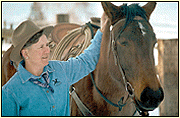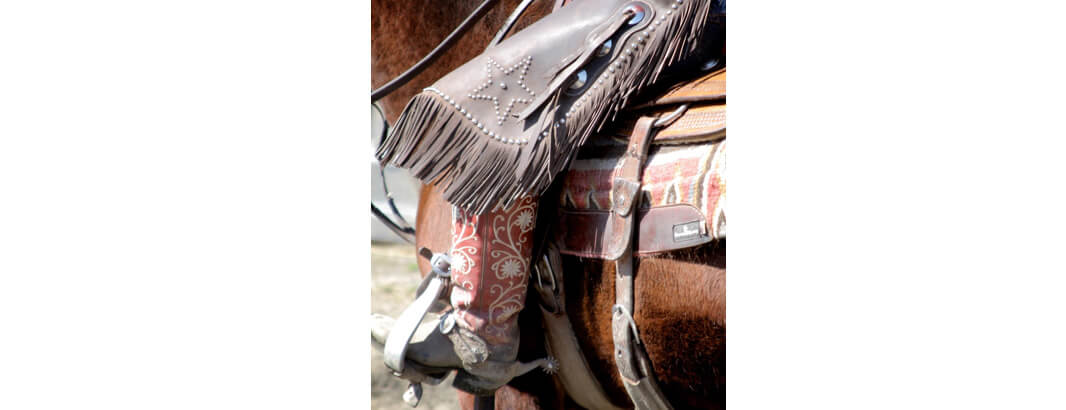How to Properly Use Leg Pressure to Control Your Horse
by Allison Trimble

Horses are trained using the concept of pressure and release. This can come in many forms including through the halter rope, through your body during groundwork, and from the reins while riding. One of the most important applications of pressure and release comes from the rider’s legs.
In the videos that I share, I get the most response to videos involving leg yielding and I thought it would be great to break the subject down. It is important to remember that the legs of the rider are essential in controlling the body of the horse.
There are two ways that the rider’s legs are used. The first is for acceleration. This is typically used by squeezing or bumping in the position that the rider’s legs naturally fall. In the horse at rest, standing, or when he is moving forward, this position falls behind the drive point of the horse. If moving forward, the rider should first activate their legs, and then ask for the horse’s face. Forward motion is established first, collection second. Conversely, in the backup the rider’s hands are first used to draw the horse backward, shifting weight onto the horse’s hind end, and moving the rider’s legs in front of the drive point. Then the rider’s legs either squeeze or bump to accelerate.
The second way the rider’s legs are used is to move, or control, the parts of the horse’s body. Mentally I break the horse in to three parts: Part 1 is the shoulders, part 2 is the rib cage and part 3 is the hindquarters or hip. There are corresponding leg positions on the horse’s side. Position 1 helps to control the shoulders laterally and to “break” or bend the horse behind the shoulder, but in front of the rib cage. This requires the rider to move their leg forward and turn their toe out to reach this position with their spur or heel. Position 2 is used to control the rib cage of the horse and is typically where the rider’s leg naturally falls. If wearing spurs, it is still necessary to turn the toe out so that the end of the spur is finding the proper mark. This position is most often used for side passing, and for leg yielding in a forward motion to move the entire body of the horse laterally. Position 3 is used to isolate the hip. This position requires the rider’s leg to draw back and push the hip of the horse either way. One problem I often see here is that the rider’s spur can hit the back cinch and give a mixed signal to the horse. This position is used to move the haunches for practical use and in lead departures and lead changes.
Regardless of the way the rider’s legs are used, it is critical to remember that this is a cue based on pressure and release. It is crucial that the pressure is applied, escalated and released when the desired motion is achieved. Initial contact should always be with the calf of the rider and then slowly turned to spur as the rider’s toe is turned down and the spur rowel is activated. I find it very common that people have a tough time finding the release with their legs. Whether it is because they are unstable and using them for balance, or just don’t have good timing, the result is almost always that a horse becomes agitated or numb. Focus on the timing, escalation, and release. Pressure should always begin light—remembering that these are animals with skin receptors that allow them to feel and twitch off a small bug, and escalate to a level that garners a response. The release needs to be as soft as the initial contact. I find often that people release in a way that is either startling to the horse, or leaves them hanging and falling back towards the initial pressure. A correct release requires only a soft step backward from the currently applied pressure.
In closing, I want to clarify that a horse is not born with these pressure and release “buttons.” This is a process that starts with first learning to move away from pressure; then the horse is subsequently trained to respond to additional cues. In many cases, the rider is expecting the horse to respond to something that has never been taught or introduced to them. Think of it as math. No one would expect a student to do calculus who is not capable of simple addition and subtraction. There is a progression of learning in mathematics, and there is a similar progression in horse training: mastery of the basics before more complicated tasks.
Published November 2013 Issue

Alice was born on a ranch in eastern Oregon, the only daughter in a family of five brothers. She learned to ride behind the back of the saddle holding on to her brother’s belt loops. In the past 15 years Alice has studied with horsemen such as Tom Dorrance, Ray Hun, Dennis Reis, and Bettina Drummon. Her focus is on building a balanced relationship, applying Classical Dressage and Traditional Vaquero principles, via multi-day horsemanship retreats at her ranch in eastern OR.






